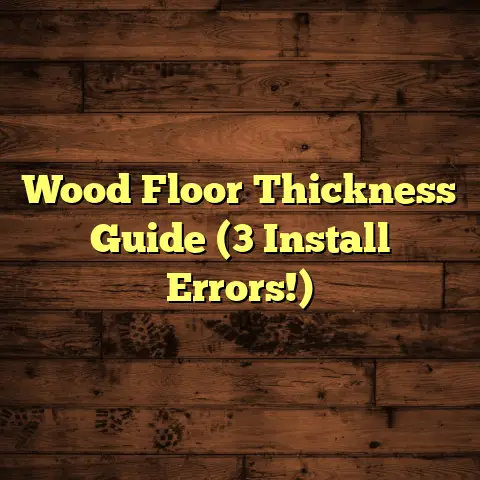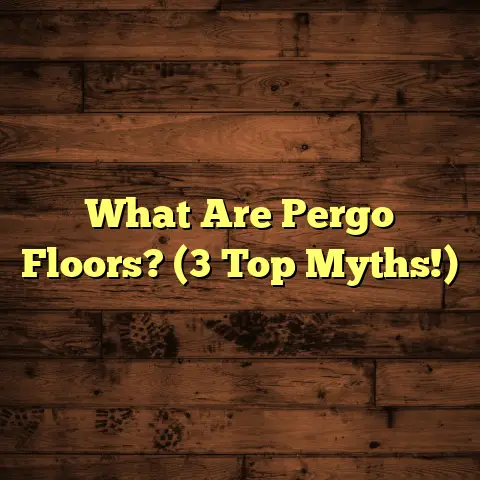Laminate Floor Cleaning Tools? (4 Must-Have Supplies!)
I’m excited to share my insights on keeping your laminate floors looking their absolute best.
We’ve seen laminate flooring evolve from basic, budget-friendly options to stunning replicas of hardwood, stone, and tile. It’s no wonder they’re a popular choice for many of us.
But let’s be real, even the toughest laminate needs TLC. That’s where having the right cleaning tools comes in. Trust me, it makes all the difference in maintaining that “just installed” look and extending the life of your floors.
In this article, I’ll walk you through the essential tools that every laminate floor owner should have. We’ll cover why they matter, how to use them, and even some DIY cleaning solutions.
So, grab a cup of coffee, and let’s dive in!
Section 1: Understanding Laminate Flooring
Definition and Composition
What exactly is laminate flooring?
Well, it’s a multi-layer synthetic flooring product fused together through a lamination process.
Typically, it consists of a high-density fiberboard (HDF) core, a decorative layer (that beautiful wood or tile print), and a tough, transparent wear layer on top. This wear layer is what protects your floor from scratches and everyday wear and tear.
Unlike hardwood, which is solid wood all the way through, laminate is engineered for durability and affordability.
Popularity and Benefits
Why is laminate so popular?
For starters, it’s incredibly versatile. You can find laminate that mimics virtually any type of flooring, from classic oak to exotic stone.
Plus, it’s much more budget-friendly than solid hardwood or natural stone. Installation is often easier too, with many products featuring click-lock systems that even a DIY novice can handle.
According to a report by Grand View Research, the global laminate flooring market size was estimated at USD 39.73 billion in 2022 and is expected to reach USD 54.29 billion in 2030. That’s a lot of laminate!
Challenges in Maintenance
Now, let’s talk about the challenges.
While laminate is durable, it’s not indestructible. One of the biggest enemies of laminate is moisture. Too much water can seep into the seams and cause swelling or warping.
Scratches are another concern, especially in high- traffic areas or homes with pets. And of course, stains can be a pain to remove if you don’t tackle them quickly.
That’s why choosing the right cleaning tools and techniques is so important.
Section 2: The Importance of Using the Right
Cleaning Tools
Why Specialized Tools Matter
Have you ever used a scouring pad on a non-stick pan? The same principle applies to laminate floors. Using the wrong tools can cause irreversible damage.
Abrasive cleaners can scratch the surface, dulling the finish and making it more susceptible to future damage. Harsh chemicals can strip away the protective wear layer, leaving your floor vulnerable to stains and moisture.
Believe me, I’ve seen it happen. A client once used a steel wool pad to remove a stubborn stain, and it left behind a swirl of scratches that were impossible to fix without replacing the entire floor.
Overview of Cleaning Frequency
How often should you clean your laminate floors?
Well, it depends on your lifestyle. In general, a quick sweep or dust-mopping should be done daily or every other day to remove loose dirt and debris.
Weekly cleaning with a damp microfiber mop and pH-balanced cleaner is usually sufficient for most households. However, if you have kids or pets, you might need to clean more frequently.
Seasonal deep cleaning is also a good idea to remove built-up grime and restore the shine to your floors.
Section 3: Must-Have Cleaning Supplies
Okay, let’s get to the good stuff!
Here are the four essential cleaning tools that every laminate floor owner should have:
- Microfiber Mop
- pH-Balanced Floor Cleaner
- Soft-Bristled Brush or Broom
- Lint-Free Cloths or Towels
Let’s break down each one in detail.
1. Microfiber Mop
Benefits of Microfiber Mops
Microfiber mops are a game-changer for laminate floors.
Unlike traditional cotton mops, microfiber is incredibly absorbent and effective at trapping dust, dirt, and grime. The tiny fibers create a larger surface area, allowing them to pick up more debris with each swipe.
Plus, microfiber is non-abrasive, so it won’t scratch your laminate floors.
Choosing the Right Microfiber Mop
When choosing a microfiber mop, consider the size of your floors. A wider mop head will cover more surface area, making cleaning faster and more efficient.
Look for a mop with an adjustable handle so you can customize the height for your comfort.
Also, make sure the mop head is machine-washable for easy cleaning.
Using and Maintaining Your Mop
To use your microfiber mop, start by sweeping or vacuuming your floors to remove any loose debris.
Then, lightly dampen the mop head with your pH-balanced cleaner. Avoid soaking the mop, as excess water can damage your laminate floors.
Mop in a back-and-forth motion, overlapping each stroke slightly. Rinse the mop head frequently to remove dirt and grime.
After each use, wash the mop head in your washing machine with a mild detergent. Avoid using fabric softener, as it can reduce the absorbency of the microfiber.
2. pH-Balanced Floor Cleaner
What is pH-Balanced Cleaner?
pH-balanced cleaners are specifically formulated to be gentle on laminate floors. The pH scale ranges from 0 to 14, with 7 being neutral. Acidic cleaners have a pH below 7, while alkaline cleaners have a pH above 7.
Laminate floors are best cleaned with a neutral pH cleaner (around 7) to avoid damaging the protective wear layer.
Key Attributes to Look For
When choosing a laminate floor cleaner, look for products that are specifically labeled as “pH- balanced” or “neutral pH.”
Avoid cleaners that contain harsh chemicals like bleach, ammonia, or vinegar, as these can damage your laminate floors.
Also, look for cleaners that are non-toxic and biodegradable, especially if you have kids or pets.
Commercial and Homemade Cleaners
There are many great commercial laminate floor cleaners available on the market. Some of my favorites include:
- Bona Hard-Surface Floor Cleaner
- Method Squirt + Mop Hard Floor Cleaner
- Weiman Wood Floor Cleaner
If you prefer a homemade solution, try this simple recipe:
- 1/4 cup white vinegar
- 1 gallon warm water
Mix the vinegar and water in a bucket. Dampen your microfiber mop with the solution and clean your floors as usual.
Note: While vinegar is often recommended as a natural cleaner, it’s important to use it sparingly on laminate floors. Too much vinegar can strip away the finish and cause damage over time. I would personally test it on an inconspicuous area first to ensure it doesn’t cause any discoloration.
3. Soft-Bristled Brush or Broom
Importance of Soft Bristles
A soft-bristled brush or broom is essential for removing loose dirt, dust, and debris from your laminate floors without scratching the surface.
Hard-bristled brushes can be too abrasive and can leave behind unsightly scratches.
Types of Effective Brushes
Look for a broom with fine, flexible bristles that can easily reach into corners and crevices. A dustpan with a rubber edge will also help you collect debris more effectively.
Alternatively, you can use a vacuum cleaner with a soft brush attachment to remove loose dirt and dust. Just be sure to turn off the beater bar, as it can scratch your laminate floors.
How Often to Use
I recommend sweeping or vacuuming your laminate floors daily or every other day to prevent dirt and dust from building up.
This simple step can go a long way in keeping your floors looking their best.
4. Lint-Free Cloths or Towels
Role of Lint-Free Cloths
Lint-free cloths or towels are perfect for polishing and drying your laminate floors after cleaning.
They won’t leave behind any streaks or residue, ensuring a sparkling finish.
Tips for Selecting the Right Cloths
Microfiber cloths are an excellent choice for laminate floors. They’re soft, absorbent, and lint-free.
You can also use old t-shirts or towels, as long as they’re clean and free of lint.
Importance of Drying Properly
Drying your laminate floors after cleaning is crucial to prevent moisture damage.
Water that sits on the surface can seep into the seams and cause swelling or warping.
Use a clean, dry lint-free cloth to wipe up any excess water after mopping.
Section 4: Additional Cleaning Tips and
Techniques
Daily Maintenance Routine
Here’s a simple daily cleaning routine that incorporates the must-have supplies:
- Sweep or vacuum your floors with a soft- bristled brush or vacuum cleaner.
- Dampen a microfiber mop with a pH-balanced cleaner.
- Mop your floors in a back-and-forth motion, overlapping each stroke slightly.
- Dry your floors with a clean, lint-free cloth.
Spot Cleaning
For spot cleaning stains and spills, follow these steps:
- Blot up the spill immediately with a clean, dry cloth.
- If the stain persists, dampen a lint-free cloth with a pH-balanced cleaner and gently rub the stain.
- Dry the area with a clean, dry cloth.
For tough stains, you may need to use a specialized laminate floor stain remover. Just be sure to test it on an inconspicuous area first to ensure it doesn’t damage your floors.
Seasonal Deep Cleaning
For seasonal deep cleaning, follow these steps:
- Move all furniture and rugs out of the room.
- Sweep or vacuum your floors thoroughly.
- Mix a solution of pH-balanced cleaner and warm water in a bucket.
- Dampen a microfiber mop with the solution and mop your floors, paying special attention to high-traffic areas.
- Rinse the mop head frequently to remove dirt and grime.
- Dry your floors with a clean, lint-free cloth.
For extra shine, you can use a laminate floor polish after cleaning. Just be sure to follow the manufacturer’s instructions carefully.
Conclusion: The Path to Pristine Laminate Floors
So, there you have it!
The four must-have cleaning supplies for keeping your laminate floors looking their absolute best.
By investing in a microfiber mop, pH-balanced cleaner, soft-bristled brush, and lint-free cloths, you can protect your floors from damage and extend their lifespan.
Remember, proper maintenance is key to preserving the beauty of your laminate floors.
Implement these tips into your cleaning routine, and you’ll be well on your way to achieving pristine laminate floors that you can be proud of.
Happy cleaning!





